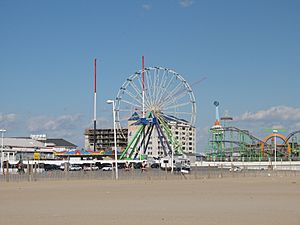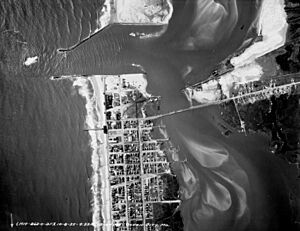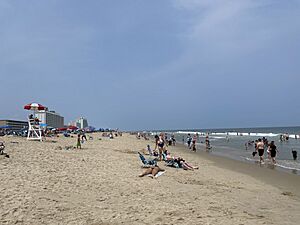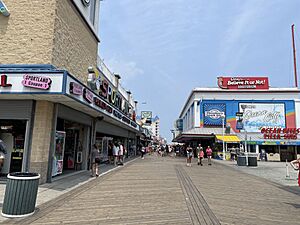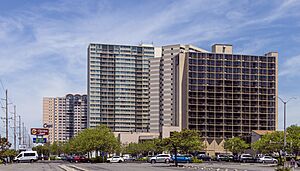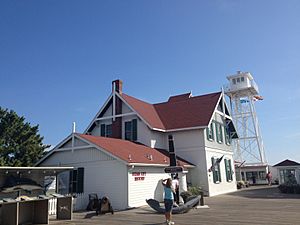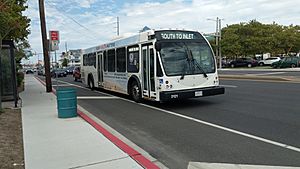Ocean City, Maryland facts for kids
Quick facts for kids
Ocean City, Maryland
|
|||||
|---|---|---|---|---|---|
| Town of Ocean City | |||||

Ocean City in July 2018
|
|||||
|
|||||
| Nickname(s):
"The White Marlin Capital of the World", "OC", "OCMD"
|
|||||

Location in Worcester County and Maryland
|
|||||
| Country | United States | ||||
| State | Maryland | ||||
| County | Worcester | ||||
| Founded | 1875 | ||||
| Incorporated | 1880 | ||||
| Government | |||||
| • Type | Council-manager | ||||
| Area | |||||
| • Total | 9.65 sq mi (24.99 km2) | ||||
| • Land | 4.53 sq mi (11.73 km2) | ||||
| • Water | 5.12 sq mi (13.25 km2) 53.05% | ||||
| Elevation | 7 ft (2 m) | ||||
| Population
(2020)
|
|||||
| • Total | 6,844 | ||||
| • Density | 1,510.48/sq mi (583.22/km2) | ||||
| 320,000–345,000 estimated summer weekend population | |||||
| Time zone | UTC−5 (Eastern) | ||||
| • Summer (DST) | UTC−4 (Eastern) | ||||
| ZIP Codes |
21842–21843
|
||||
| Area code(s) | 410, 443, and 667 | ||||
| FIPS code | 24-58225 | ||||
| GNIS feature ID | 0586284 | ||||
| Website | www.oceancitymd.gov | ||||
Ocean City, also known as the Town of Ocean City, is a popular beach town on the Atlantic Ocean in Worcester County, Maryland, USA. While about 6,844 people live there all year, Ocean City becomes super busy in summer! It welcomes between 320,000 and 345,000 visitors on summer weekends. Up to eight million people visit each year. In summer, it's the second most populated town in Maryland, right after Baltimore. It's part of the larger Salisbury area.
During the busy summer, many extra workers come to Ocean City. This includes over 1,000 seasonal police officers and more firefighters. The town hosts many fun events throughout the year. These include Sunfest, Springfest, Bike Week, and Winterfest of Lights. These events happen on the famous Ocean City Boardwalk and at the Roland E. Powell Convention Center. Ocean City also hosts the yearly Maryland State Firefighters Convention in June. This week-long event honors firefighters from all over the state.
Contents
History of Ocean City
Early Beginnings
Long before Europeans arrived in the 1600s, Native American groups lived along the Maryland coast. These included the Assateague and Nanticoke peoples. An Englishman named Thomas Fenwick later got the land where Ocean City now stands.
In 1869, a businessman named Isaac Coffin built the first beach house for visitors. Back then, people traveled by stagecoach and ferry to reach the area. Soon, more simple guesthouses were built on the sandy strip. This attracted important business people from Maryland, Philadelphia, and Delaware. They decided to develop the area. They divided the land into 250 lots and formed a company to help build the town.
Before 1870, this area was known as "The Ladies' Resort to the Ocean."
Growth and Development
The first big hotel, the Atlantic Hotel, opened on July 4, 1875. It was owned by the Atlantic Hotel Company. Later, Charles W. Purnell bought it in 1923. As of 2014, the Purnell family still owns and runs it. The hotel had over 400 rooms and offered dancing and billiard rooms.
By 1878, tourists could take a train from Berlin to the shores of Sinepuxent Bay. By 1881, the train line reached the beach itself. This brought visitors right into town. It also helped send local fish from Ocean City to bigger cities.
Major Changes in the 20th Century
In 1930, the Ocean City Beach Patrol was created to keep swimmers safe. The first lifeguard, Edward Lee Carey, watched over bathers.
A big hurricane in 1933 created the Ocean City Inlet. This storm also destroyed the train tracks across Sinepuxent Bay. The inlet separated Ocean City from Assateague Island. The Army Corps of Engineers made the inlet permanent. This helped Ocean City become an important fishing port. It gave boats easy access to the Atlantic Ocean.
In the late 1930s, a new channel was dug on the bay side of Ocean City. This allowed larger boats to use Sinepuxent Bay. The sand from this digging helped create new land on the western shore. This led to the building of Chicago Avenue and St. Louis Avenue.
Ocean City grew very quickly after World War II. In 1952, the Chesapeake Bay Bridge made it easy for people from the Baltimore–Washington metropolitan area to visit. In 1964, the Chesapeake Bay Bridge-Tunnel opened a new route from the south. Ocean City became one of the biggest vacation spots on the East Coast.
By the 1970s, many high-rise condominium buildings were constructed. These gave people great views of the ocean. However, the beach started to get smaller in the 1980s and 1990s. This led to projects to add more sand to the beach.
In 1994, a fire during the annual Sunfest destroyed five businesses on the boardwalk. Today, the building that once held a wax museum is home to the Ripley's Believe it or Not! museum.
Ocean City in the 21st Century
In 2002, Ocean City started a big project to restore its beaches. They pumped tons of sand from offshore onto the beach. They also rebuilt the sand dunes in front of the buildings. Another similar project happened after the 2006 tourist season.
In 2006, the city built the Ocean City Firefighter's Memorial. It honors local firefighters and those who died in the September 11 attacks. The monument includes a piece of steel from the World Trade Center towers.
By 2011, about 8 million visitors came to Ocean City each year.
In 2022, Ocean City announced the first Oceans Calling Festival. This music event was set to feature major artists like the Dave Matthews Band, Cyndi Lauper, and Alanis Morissette. However, Tropical Storm Ian caused the event to be moved to fall 2023.
Ocean City continues to grow westward across the bay. It is expanding towards Berlin and Ocean Pines.
Geography and Climate
Location and Landforms
Ocean City is located on a narrow strip of land called Fenwick Island. This landform is a spit, which is a sandy strip of land extending into the water. The town shares this island with South Bethany and Fenwick Island, Delaware.
The southern tip of Ocean City has an inlet. This inlet was formed by a hurricane in 1933. The storm caused rivers and bays to overflow. The water then cut a 50-foot opening from the bay to the ocean. Business people in Ocean City had wanted an inlet for a long time. So, they built jetties to make sure the inlet stayed open. This divided Ocean City's land from what is now Assateague Island.
Ocean City's Climate
Ocean City has a humid subtropical climate. This means it has long, warm to hot, and humid summers. Winters are cool, and it rains throughout the year. Ocean City gets about 2300 hours of sunshine each year, which is more than the average for the USA.
The Atlantic Ocean helps keep temperatures mild in Ocean City. In summer, a cool sea breeze often blows in the afternoon. Temperatures usually don't reach 90°F (32°C) more than 10 days a year. However, in 2010, the temperature hit a record 103°F (39°C). Sometimes, extreme heat with high humidity can make it feel like 100°F (38°C) or more.
Direct hits from tropical storms and hurricanes are rare. This is because the Outer Banks of North Carolina are to the south. The hurricane season runs from June to November. It is busiest from late August through September.
In winter, Ocean City has cool weather. The average high is about 45°F (7.5°C). But mild temperatures in the 50s and 60s Fahrenheit (10-15°C) are common. The temperature rarely stays below freezing for more than 5.8 days a year. The coldest temperature ever recorded was -6°F (-21°C). Ocean City gets a small amount of snow, usually 6 to 12 inches (15-30 cm) per winter. February is usually the snowiest month.
| Climate data for Ocean City Beach, MD (1981-2010 Averages) | |||||||||||||
|---|---|---|---|---|---|---|---|---|---|---|---|---|---|
| Month | Jan | Feb | Mar | Apr | May | Jun | Jul | Aug | Sep | Oct | Nov | Dec | Year |
| Record high °F (°C) | 77 (25) |
78 (26) |
88 (31) |
94 (34) |
98 (37) |
102 (39) |
103 (39) |
100 (38) |
99 (37) |
94 (34) |
84 (29) |
78 (26) |
103 (39) |
| Mean daily maximum °F (°C) | 44.6 (7.0) |
46.1 (7.8) |
53.1 (11.7) |
61.1 (16.2) |
69.9 (21.1) |
79.5 (26.4) |
83.7 (28.7) |
82.4 (28.0) |
77.3 (25.2) |
67.8 (19.9) |
57.5 (14.2) |
49.0 (9.4) |
64.3 (17.9) |
| Daily mean °F (°C) | 36.1 (2.3) |
37.7 (3.2) |
44.0 (6.7) |
52.6 (11.4) |
61.4 (16.3) |
71.3 (21.8) |
76.0 (24.4) |
74.7 (23.7) |
68.7 (20.4) |
59.1 (15.1) |
48.3 (9.1) |
40.4 (4.7) |
55.9 (13.3) |
| Mean daily minimum °F (°C) | 27.6 (−2.4) |
29.3 (−1.5) |
35.0 (1.7) |
44.1 (6.7) |
53.0 (11.7) |
63.1 (17.3) |
68.3 (20.2) |
67.1 (19.5) |
60.1 (15.6) |
50.5 (10.3) |
39.2 (4.0) |
31.7 (−0.2) |
47.4 (8.6) |
| Record low °F (°C) | −6 (−21) |
−2 (−19) |
8 (−13) |
22 (−6) |
30 (−1) |
40 (4) |
45 (7) |
41 (5) |
31 (−1) |
22 (−6) |
15 (−9) |
−2 (−19) |
−6 (−21) |
| Average precipitation inches (mm) | 3.43 (87) |
3.06 (78) |
3.99 (101) |
3.36 (85) |
3.63 (92) |
3.31 (84) |
3.37 (86) |
4.66 (118) |
3.48 (88) |
3.30 (84) |
3.14 (80) |
3.64 (92) |
42.37 (1,076) |
| Average relative humidity (%) | 68.8 | 68.4 | 63.9 | 66.0 | 71.4 | 74.4 | 74.8 | 76.3 | 74.7 | 72.9 | 71.1 | 69.5 | 71.0 |
| Average dew point °F (°C) | 27.4 (−2.6) |
29.0 (−1.7) |
33.5 (0.8) |
42.7 (5.9) |
53.3 (11.8) |
63.4 (17.4) |
68.4 (20.2) |
67.7 (19.8) |
61.5 (16.4) |
50.8 (10.4) |
41.2 (5.1) |
31.9 (−0.1) |
47.7 (8.7) |
| Source 1: NOAA | |||||||||||||
| Source 2: PRISM | |||||||||||||
People of Ocean City
| Historical population | |||
|---|---|---|---|
| Census | Pop. | %± | |
| 1880 | 49 | — | |
| 1890 | 85 | 73.5% | |
| 1900 | 365 | 329.4% | |
| 1910 | 476 | 30.4% | |
| 1920 | 711 | 49.4% | |
| 1930 | 946 | 33.1% | |
| 1940 | 1,052 | 11.2% | |
| 1950 | 1,234 | 17.3% | |
| 1960 | 983 | −20.3% | |
| 1970 | 1,493 | 51.9% | |
| 1980 | 4,946 | 231.3% | |
| 1990 | 5,146 | 4.0% | |
| 2000 | 7,173 | 39.4% | |
| 2010 | 7,102 | −1.0% | |
| 2020 | 6,844 | −3.6% | |
| U.S. Decennial Census | |||
Population and Diversity
In 2020, about 6,844 people lived in Ocean City all year. There were 3,723 households. The town had about 1,510 people per square mile. Most residents (90%) were White. About 5.8% were Hispanic, and 0.8% were African American.
In 2010, there were 7,102 people living in the town. About 9.1% of residents were under 18 years old. Many residents were older, with 29.6% being 65 or older. The average age in town was 54.2 years.
Economy and Attractions
Ocean City stretches for over 9 miles. It has many hotels, motels, and apartment buildings. There are also shopping centers and homes. The southern part of town is home to the famous Ocean City Boardwalk.
The Boardwalk and Amusement Parks
The boardwalk is the main place for shopping and fun in Ocean City. It has two amusement parks. These are Trimpers Rides and The Pier, which is now called Jolly Roger at The Pier. The downtown area, known as Old Town, has older Victorian-style houses.
Fishing Capital
Ocean City has a long history of fishing. It's known as the "White Marlin Capital of the World." In summer, many boats go out to catch fish like billfish, tuna, and wahoo. In early August, the White Marlin Open is held. This is one of the biggest fishing tournaments in the world. Prizes for the largest fish can be over $1 million!
Arts and Culture
Ocean City Boardwalk Fun
The Ocean City Boardwalk starts at South 2nd Street. It goes all the way up to 27th Street. The boardwalk is full of places to eat, shops, arcades, and rides.
The first boardwalk was built in 1902 and was called "Atlantic Avenue." A storm in 1962 damaged it, but it was rebuilt to be 2.25 miles long. In 1985, Hurricane Gloria caused a lot of damage. After that, a concrete sea wall was built to protect it. This also led to projects to add more sand to the beaches.
In 2012, Hurricane Sandy damaged half of the boardwalk. But it has been rebuilt to its original length. Many tourists visit it every year.
Trimper's Rides: A Historic Park
Also in South Ocean City is Trimper's Rides. This historic amusement park started in 1893. It has one of the oldest working carousel rides in the United States. This carousel was built in 1912. It even won an award in 1996 for being a historic carousel.
Midtown Dining and Nightlife
The Midtown area of Ocean City is from 28th Street to 90th Street. Here you'll find many restaurants along the bay and places for evening fun. Jolly Roger Amusement Park and the Roland E. Powell Convention Center are in Midtown. Seacrets, a very popular entertainment spot, is also here. It's known for bringing in many tropical plants in the summer.
Historical Places to Visit
Ocean City has several interesting historical sites:
- The Sandy Point Site and St. Paul's by-the-sea Protestant Episcopal Church are listed on the National Register of Historic Places.
- You can see an anchor from an old sailboat wreck from 1870.
- The Atlantic Hotel was rebuilt in 1926 after a fire. It's one of the oldest hotels in Ocean City.
- The Ocean City Life Saving Station Museum was built in 1891. It became a museum in 1978.
Senior Week and Festivals
Ocean City is famous for its Senior Week activities. This is when high school graduates from Maryland and nearby states visit. Senior Week usually starts the first week after graduation.
The city also hosts the Brine Beach Lax Festival (Lacrosse) in June. The Ocean City Film Festival happens every year in early March.
Parks and Recreation
Ocean Bowl Skatepark
Ocean Bowl Skatepark in South Ocean City opened in June 1976. It was the first skate park on the East Coast of the United States. It is also the longest-running city-owned skatepark in the country. The original park was rebuilt in 1998. The park has hosted the National Dew Tour several times.
Media
Radio Stations
Ocean City has an emergency radio system. It broadcasts on two FM frequencies.
WOCM broadcasts from studios located at Seacrets. Its call letters stand for "We are Ocean City Maryland."
Music Mentions
Ocean City is mentioned in the Car Seat Headrest song “Beach Life-In-Death.”
Getting Around Ocean City
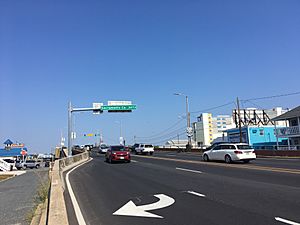
Roads and Bridges
Ocean City has one main road that runs north and south. It's called Maryland Route 528, or the Coastal Highway. Two bridges connect the mainland to Ocean City:
- U.S. Route 50, also known as Ocean Gateway, crosses the Harry W. Kelley Memorial Bridge. Ocean City is the very end of US 50 on the East Coast.
- Maryland Route 90 (Ocean City Expressway), crosses the Assawoman Bay Bridge.
Public Transportation
Ocean City has its own public transportation system. It's called Ocean City Transportation. They run the Coastal Highway Beach Bus and the West Ocean City Park-N-Ride Beach Bus. They also have an Express Beach Bus for special events. A trackless train shuttle, called the Boardwalk Tram, runs along the boardwalk in summer.
Ocean City's transit service also connects with Shore Transit. This allows people to travel to other places.
From May to September, the DART First State Beach Bus connects with the Coastal Highway Beach Bus.
The Ocean City Municipal Airport is west of downtown. It serves small planes and charter flights.
Utilities and Services
Delmarva Power provides electricity to Ocean City. Sandpiper Energy provides natural gas. The town's Water Department supplies water. They use 25 wells and 3 treatment plants. The Public Works department handles wastewater and trash. The town's trash is sent to a plant that turns waste into energy.
Safety Services
The Ocean City Police Department provides police services. They have 105 full-time officers and about 100 to 110 seasonal officers. The Ocean City Fire Department provides fire protection. It has over 200 volunteer members and over 100 career members.
Notable People
- Spiro Agnew, former U.S. vice president
- Carmen M. Amedori, Maryland State Delegate, actor, author, former journalist
- Charles L. Calhoun, first Master Chief Petty Officer of the Coast Guard
- Devin Dodson, racing driver
- James N. Mathias Jr., Maryland state senator, and past mayor
- Erica Messer, television writer
- Michael Sorce, former radio talk show host known by his on-air name Don Geronimo
- Jennifer Hope Wills, actress, Christine Daaé in The Phantom of the Opera on Broadway
Sister Cities
Ocean City has three sister cities:
 Finale Ligure, Italy
Finale Ligure, Italy Pärnu, Estonia
Pärnu, Estonia Rehoboth Beach, Delaware, U.S.
Rehoboth Beach, Delaware, U.S.
See also
 In Spanish: Ocean City (Maryland) para niños
In Spanish: Ocean City (Maryland) para niños







